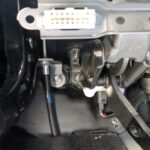Navigating the intricacies of motorcycle maintenance often requires specialized tools, and when it comes to modern Ducatis, diagnostic tools are indispensable. For owners looking to understand and maintain their bikes, especially models with OBD2 systems, choosing the right diagnostic tool and adapter is crucial. This guide dives into the world of Ducati diagnostic tools, focusing on OBD2 compatibility and helping you select the best option for your needs.
Understanding Ducati Diagnostic Interfaces
Ducati motorcycles, like many modern vehicles, utilize On-Board Diagnostics (OBD) systems to monitor various aspects of the bike’s performance. Initially, Ducati employed proprietary diagnostic interfaces. However, with the increasing standardization in the automotive industry, newer Ducati models have transitioned to OBD2, a more universally recognized standard.
For Ducatis manufactured before 2021, you’ll typically encounter a different type of diagnostic port, often a flat, multi-pin connector. These systems predate the widespread adoption of OBD2 in motorcycles. Diagnostic tools for these bikes often require specific adapters to connect to these proprietary ports.
Post-2021 Ducati models, aligning with modern standards, generally feature the standard OBD2 port, similar to those found in cars. This transition simplifies diagnostics as it opens up compatibility with a wider range of OBD2 diagnostic tools. However, even with OBD2 ports, the communication protocols and specific diagnostic codes can still be brand-specific, requiring tools with Ducati-specific capabilities.
OBD2 Adapters: Bridging the Connection
Whether you own a pre-2021 or a newer Ducati, adapters often play a crucial role in connecting your diagnostic tool.
For older Ducatis with proprietary ports, you’ll need an adapter that converts the bike’s connector to the standard OBD2 interface. These adapters essentially act as a bridge, allowing generic OBD2 tools or more advanced motorcycle diagnostic scanners to communicate with your Ducati’s system. Options range from basic OBD2-to-6-pin adapters to more specialized Ducati-specific adapters.
For newer Ducatis with OBD2 ports, while a direct OBD2 connection is possible, some diagnostic tools, particularly those designed for broader vehicle coverage like the iScan mentioned in user discussions, might still utilize a main serial-to-OBD2 connector. In such cases, you might consider using a simpler OBD2-to-6-pin adapter, bypassing the need for multiple adapter connections, as highlighted by users seeking cleaner setups.
There’s a debate on whether to opt for Ducati-specific adapters versus generic OBD2 adapters. Ducati-branded adapters are designed and tested by the manufacturer, ensuring compatibility and reliability. Dealers often use these in service environments, suggesting a level of dependability. However, they might come at a premium price.
Generic OBD2 adapters, readily available from online retailers like Amazon, offer a more cost-effective alternative. These can range in quality and reliability, so reading reviews and ensuring compatibility with your specific Ducati model and diagnostic tool is essential. The key is to find an adapter that reliably translates the signals between your tool and the bike’s diagnostic system.
iScan Diagnostic Tool and Adapter Considerations
The iScan diagnostic tool, as mentioned in user discussions, is a popular option in the motorcycle diagnostic space. It often comes with a main OBD2 connector and various adapter leads to suit different motorcycle brands and models.
For Ducati owners using iScan, the choice of adapter becomes relevant. The tool might include a lead designed for pre-2021 Ducati interfaces. For newer OBD2 Ducatis, users might consider direct OBD2-to-6-pin adapters to streamline the connection, avoiding a chain of adapters.
User experiences suggest that while Ducati-specific adapters from dealers are considered reliable, generic OBD2-to-6-pin adapters can also function effectively, especially for less frequent, personal use. The crucial factor is ensuring the chosen adapter correctly bridges the connection and allows for accurate data transmission between the diagnostic tool and the Ducati’s ECU (Engine Control Unit).
Choosing the Right Diagnostic Path
Selecting the correct Ducati diagnostic tool and OBD2 adapter hinges on several factors:
- Your Ducati Model Year: Pre-2021 models will likely require adapters to convert to OBD2, while post-2021 models may offer direct OBD2 connectivity.
- Diagnostic Tool Capabilities: Consider whether you need a basic OBD2 scanner for reading fault codes or a more advanced motorcycle-specific tool like iScan for in-depth diagnostics and functions.
- Frequency of Use: For occasional home maintenance, a reliable generic adapter might suffice. For frequent or professional use, a Ducati-specific or higher-quality adapter could be a worthwhile investment.
- Budget: Ducati-specific adapters may be pricier, while generic options offer cost savings. Balance cost with reliability and your diagnostic needs.
Ultimately, understanding your Ducati’s diagnostic interface and the capabilities of your chosen tool, coupled with a compatible and reliable OBD2 adapter, is key to effective motorcycle diagnostics and maintenance. Whether you opt for a Ducati-branded adapter or a quality generic alternative, ensure it facilitates a stable and accurate connection to unlock the diagnostic potential of your Ducati.

